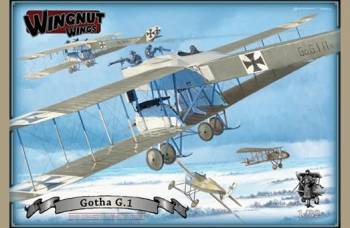1/32 Gotha G.1
|
|
 |
But only from... WINGNUT WINGS
All items from... WINGNUT WINGS
- Released on 12 June 2019
- 63cm x 37cm
- High quality Cartograf decals for 5 aircraft
- 349 high quality injection moulded plastic parts
- 9 photo-etched metal detail parts
- 150hp Benz Bz.III engines
- 20kg & 50kg Carbonit bombs, optional lMG 08, LMG 14 & 2cm Becker cannon armament
- Fine in scale rib tape detail
- Full rigging diagrams.
Although built in very limited numbers, the highly distinctive twin engine Gotha G.1 is nevertheless an important aircraft as it set Gothaer Waggonfabrik on the path to building the more conventional bombers that they became famous for. The aircraft that would serve as the prototype Gotha G.1 was designed by Oskar Ursinus (the founder and editor of Flugsport magazine) to the German Army"s Type III aircraft specifications for a 200hp, 3 seater able to fly at over 120kph and carry 450kg for up to 6 hours. Ursinus proposed the idea of building his Kampfflugzeug (battle plane) to Fliegerersatz Abteilung 3 (FEA 3) commander Major Friedel in August 1914 with construction beginning the following month utilizing FEA 3 personnel. The Friedel-Ursinus “FU” Kampfflugzeug, having now been given the serial number B.1092/14, took to the air at the end of January 1915. The high position of the partially armoured fuselage (intended to provide protection during aerial duels) allowed the two 100hp Daimler-Mercedes D.1 engines to be placed as close together as possible to reduce the yaw effect following an engine failure and offered great visibility, but provided no protection to the crew in the event of a nose over crash. Additionally it was considered to be underpowered and the fuselage design was considered weak. After further evaluation and minor changes, “FU” B.1092/14 was sent to the eastern front for operational trials.
The license to build the “FU” Kampfflugzeug was allocated to Gothaer Waggonfabrik in March 1915 with an initial production order for 6 aircraft placed the following month (numbers 9/15 to 14/15). The main changes incorporated into the new Gotha Grossflugzeug 1 (G.1) included engines of 150-160hp, nearly equal span wings, bomb carrying capacity, wheel type control column and a modified tailplane. To facilitate transport by rail, the fuselage could be disassembled into 3 sections which did nothing to help with structural rigidity. The initial production prototype aircraft, Gotha G.1 9/15, was completed in July 1915 and powered by two 160hp Daimler-Mercedes D.III engines but the remaining 5 aircraft received 150hp Benz Bz.III engines (as found in this model kitset) and were completed over the following couple of months. The 2nd production order for another 6 aircraft was placed in July 1915 (numbers 40/15 to 45/15), all of which received 150hp Benz Bz.III engines and a 2nd gunner"s position. Photographic evidence indicates that surviving initial production aircraft were modified to include this 2nd machine gun position. This was about the same time that early Fokker Eindeckers began appearing at the front which immediately proved that lightweight single seat aircraft were much more suited to aerial fighting than large multiseat Kampfflugzeug designs like the G.1. This resulted in the 3rd and final production order aircraft placed in October 1915 (numbers 100/15 to 105/15) having a greater emphasis placed on carrying bombs and less on armour plating. These 6 aircraft were all powered by 160hp Daimler-Mercedes D.III engines. The fast progressing development of combat aircraft meant that the G.1 was considered obsolete shortly after entering service and almost all of them had been retired from front line service by February 1916. One Benz Bz.III powered G.1 was modified with a lowered fuselage, necessitating a narrower nose bottom profile to clear the propellers and was fitted with modest anti-nose-over skids. A single Gotha UWD (Ursinus Wasser Doppeldecker) seaplane version was completed in late 1915 and served until October 1916 when it was destroyed in a crash. Any history of these interesting aircraft here is of necessity very brief, therefore we encourage you to seek out the references mentioned below for a more thorough understanding.
WW1 colour schemes are contentious at the best of times and we have done our best to provide what we consider to be accurate painting information for this model. Photographic evidence shows that the fuselage fabric, wings and tailplane of the Gotha G.1 was opaque (not translucent as would be expected for clear doped linen) and appears to have been finished in all over field grey. At least one aircraft, 11/15, had its underside repainted at unit level in a pale colour, probably light blue. Metal brackets, cowlings, panels and struts appear to have been painted a very very light grey, almost white, along with some exterior wooden components. The wooden interior appears to have been darkly varnished or painted in a dark colour, possibly field grey. The various camouflage schemes applied to German aircraft of the Great War have attracted more than their fair share of debate over the years and, while we have been as meticulous as we could be, I’m sure some will not find our choices to their liking and impassioned debate will continue to rage on amongst modellers.

|

|

|

|

|

|

|

|

|







